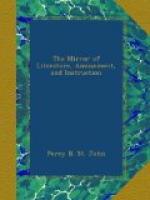Mr. Ackermann, to whom we are indebted for the naturalization of “Annuals”, announces that one of his plates in the forthcoming “FORGET ME NOT”—(4 inches by 3 in dimension) has cost one hundred guineas! The subject is “the Ruined City,” by Martin, engraved by Le Keux. Fine engraving is thus almost as dear as building-ground at Brighton.
The KEEPSAKE will appear much earlier than last year. Sir Walter Scott has written three or four articles, and two or three “noble lords” are among the contributors. Nothing can exceed the beauty of the specimens of the illustrations.
The FRIENDSHIP’S OFFERING passes into the editorial hands of Mr. T. Pringle, of whose poetical talents we have lately had some exquisite specimens.
The ANNIVERSARY.—Allan Cunningham has joined Mr. Sharp (of whose taste in “getting up” books, our readers must be aware) in a splendid volume to be called “The Anniversary.” Among the engravings are Psyche, after Sir Thomas Lawrence; Young Cottagers, after Gainsborough; the Author of Waverley in his Study, after W. Allen; a Monkey, &c. by Landseer. This is a new adventure, and we wish its projectors many anniversaries.
The CHRISTMAS BOX is to contain “A Story,” from the pen of Miss Edgworth. Mrs. Hofland, Miss Mitford, and Mrs. Hemans, likewise, contribute their pleasing aid.
The PLEDGE OF FRIENDSHIP is to be altered to The Gem, to be edited by Mr. T. Hood, whose wit and fancy will sparkle among the contributions; and who hopes that it may prove one of those “hardy annuals,” which are to become perennials; the writers are to be of “authorized popularity”—“the plates not of the common dessert kind, but a welcome service”—the engravers “as true as steel” to their originals—and the whole equally “mental” and “ornamental:” so the wight has begun already.
The WINTER’S WREATH promises to bloom more vigorously than ever, and earlier too—in September. Among the contributors are the names of Hemans, Opie, Mitford, Montgomery, Wiffen, Delta, &c.
The AMULET is to be edited, as last year, by Mr. Hall.
The BIJOU is printing with two-fold energy.
We read the other day that Schiller’s “History of the German War,” was originally published in Damen Almanach—a Lady’s Almanack! This is real azure. “Annuals” do not, however, progress on the continent; for a new one, lately published contained but a single original contribution. In America they have bloomed with some success, though not with the elegance and polish of our own country. Here their effect on the Fine Arts has been very important, and they have done much for light reading, every name of literary eminence, except those of Moore, Campbell, and Rogers, having been enlisted in their ranks. We do not, however, remember Leigh Hunt, although his pleasantries would relieve the plaintiveness of some of the poetical contributions. A few Shandean articles would be very agreeable—something like the Housekeepers in the last “Friendships’ Offering.”




